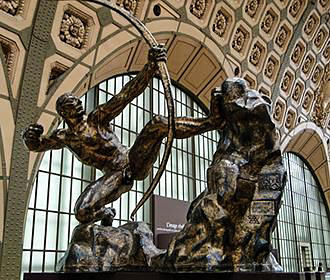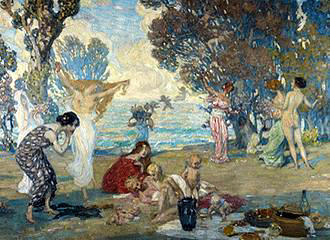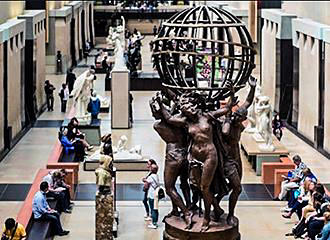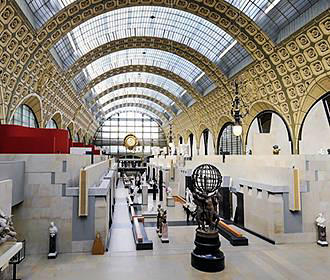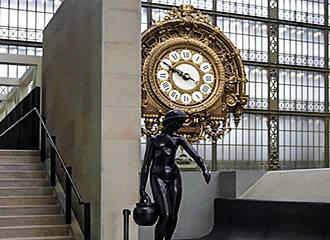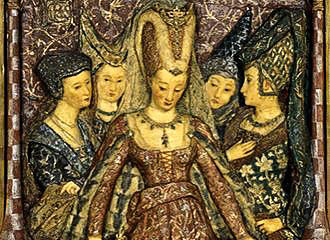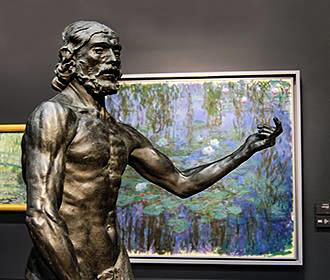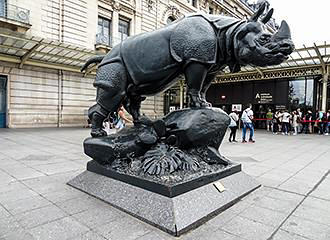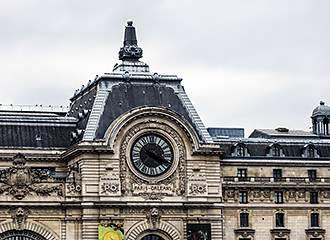The Musee d’Orsay Museum in Paris
Located on the Left Bank of the River Seine, the Musee d’Orsay is one of the museums in Paris that has a diverse collection and starts where the famous Musee du Louvre Museum finishes, as its collections dated from 1848 through to 1914.
This national French museum only opened in the December of 1986 in a former railway station and the history of the Musee d’Orsay building, in itself now classified as an historical monument in Paris, is just as fascinating as the collections inside.
Collections of the Musee d’Orsay Museum
The Musee d’Orsay was formed mainly through three different museums in Paris called the Louvre Museum, the Musee de Jeu de Paume, which is now devoted to Impressionism and the Musee d’Art Moderne that moved to the Beaubourg or Pompidou Centre, which now only holds works of art from 1870 onwards.
The idea was to accumulate different collections together, and provide a diverse, yet more complete interpretation of all forms of art from the period of 1848 through to 1914. But even the history of the collections at the Musee d’Orsay is rather fascinating, as there have also been numerous donations and bequests from private collectors that have enriched this museum over the years, along with works from the Musee d’Art Moderne de la Ville at the Palais de Tokyo.
There are different sections of the Musee d’Orsay museum that you can visit such as the painting collection with artists like Seurat, Boudin, Toulouse-Lautrec, etc, and this section provides a greater insight into the variety of different creative aspects of art from a lively and unusual period in the history of art.
Another section is dedicated to sculptures, and the 19th century was a very prolific period for all different types of sculptures that were designed to decorate homes, show status or portray beliefs and ideals, yet over time these were often disregarded and very few museums in Paris had many sculptures on display.
Within the central naive of the Musee d’Orsay Museum with its natural light that comes from the glass roof, it provides the ideal location in which to rediscover sculptures from this era. Also, having managed to obtain works from other museums in Paris like the Musee Rodin through exchanges, acquisitions, etc, there are now over 2,200 different pieces belonging to the Musee d’Orsay.
Even several years before the museum opened, a plan had already been put into place in order to obtain different collections and specific types of art work such as objets d’art, which was a logical move, considering the collection at the Louvre Museum stopped at the reign of King Louis Philippe.
Many items such as porcelain and ceramics that had been previously within the Musee du Luxembourg were initially shipped out to the Porcelain museum in Limoges in the Limousin region and the Sevres Museum, however, there were around 300 pieces that remained and went to the Musee d’Orsay.
Many other items of furniture such as a medal cabinet, wood carvings, bronze ornaments, stained glass, silverware, etc, were all brought together from places like the museum at the Chateau de Fontainebleau castle, the Chateau Compiegne, the Musee Christofle and the Musee de Cluny, which is also known as the Musee du Moyen Age.
So when the Musee d’Orsay opened, including the long term loans, there were over 1000 pieces in its decorative arts inventory, which provides the visitor with a fascinating look at the Art Nouveau period and slightly before.
Photography is one of those things that not many people consider to be fine art, and yet it has such a rich history and was one of the major inventions of the period that this museum in Paris covers, and therefore it was decided that the Musee d’Orsay should have a photographic section.
Even though the rest of the museum is specific to the time period of 1848 through to 1914, it was illogical to adhere to this within the photographic section, as the invention of the technique was officially announced in 1839, but after World War I, modern photography was now coming into the picture.
When the museum first opened, there were around 12,000 photographs, but there are now over 45,000 photographs catalogued at the museum, many of which are on display for all to enjoy and they are continuing to expand on this section to gain even more understanding on the subject and its history.
Drawings are another important collection and section within the Musee d’Orsay, many of which are from famous names like the architect Violet le Duc and are on a rotational display. The collection covers artists born after 1820 and before 1870, although paintings by Matisse are within the Musee d’Art Moderne, showing the transition between the two museums and a few other exceptions have been made on historic grounds like including Gustave Courbet.
Architecture is another major influence at this museum, not just because of the history of the Musee d’Orsay and its own building with 19th century techniques, but also this was a major turning point in construction within the more modern city of Paris, which is very seldom seen in many other museums.
Emphasis was put on specific buildings from the Second Empire and finished during the Third Republic, which shows how the architecture was changing, with the diversity of different techniques and materials utilised.
There are impressive collections held at the museum, which include sculptures, photographs, drawings, manuscripts, books, architectural drawings etc. And located at the end of the central aisle, there is a gallery dedicated to the Opera Garnier from the town planning through to its architecture and decoration, plus you will find models there to look at as well.
In addition to this there are other exhibits such as the funerary architecture of Max Bertelin who built the first French crematorium at the Pere Lachaise cemetery in Paris, the sketches of the Art Pavilion erected on the Champs de Mars by the Eiffel tower in 1889 for the Universal exhibition, and the incredible Eiffel collection, which have all been catalogued and preserved by the Musee d’Orsay.
Visiting the Musee d’Orsay Museum in Paris
The Musee d’Orsay is open on a Tuesday through to a Sunday from 9:30am, but is closed on a Monday and on National French holidays such as 1st January.
The normal closing time is 6pm, however on a Thursday there is late night opening until 9:30pm, but we would like to point out that the last admission to this museum is one hour before closing.
As well as the fabulous collections, there is a book store come boutique along with cafes called the Cafe Campana and the Cafe de L'Ours along with a restaurant in Paris located within the museum, which is in the same place as the original was, when the building was a train station. These are of course all accessible to those visiting the museum, so you do not have to worry about stopping for lunch, a meal or a snack prior to your visit.
The actual entrance to the Musee d’Orsay is 1 Rue de la Legion d’Honneur and for individuals it is entrance A on the left hand side as you look at the museum, yet if you have booked your ticket in advance, then it is entrance C on the right.
For admission to the permanent collections and exhibitions except for special exhibitions where there is an additional charge, as of 2018 it is €12 per person, but it is free entry for anyone who has purchased a Paris Museum Pass, those under the age of 18, plus people who are disabled upon proof of eligibility.
There is also a reduced rate if arriving late in the day after a set time, for example after 6pm on a Thursday when the museum has its late night opening.
Audio guides are also available to hire, which are a cost of €5 as of 2018 and cover approximately 300 major works within the permanent collections, plus they are fitted with an induction loop for those that have hearing difficulties and use a hearing aid. These audio guides are available in French, English, German, Italian, Spanish, Portuguese, Russian, Chinese, Japanese and Korean.
Now as well as the standard ticket, you can also purchase a combined ticket for the Musee d’Orsee and the Musee de l’Orangerie, which is a cost of €16 as of 2018, or alternatively you could have a combined ticket for the Musee d'Orsay and the Musee Rodin for €18. And the good things about this is whatever one of these two museums in Paris that you purchase your ticket at, it means you can then gain access to the permanent exhibitions at the other within three months of the purchase date.
Also if you are spending a few days on holiday in Paris, remember to keep hold of your Musee d’Orsay ticket, as you can get reduced rates to enter the Musee Gustave Moreau Museum, the Jean-Jacques Henner Museum and an unguided visit to the Opera Garnier Opera in Paris, within one week of the date on your Musee d’Orsay ticket.
You can purchase tickets at the Musee d’Orsay on the day, or you can also book your tickets online and if booked in advance the tickets are valid for one year from booking for the permanent collections.
However, you have to select a specific date and the exhibitions are only accessible on the date you have specified. Also, please do bear in mind that if you book online you do need to print out your tickets and take these with you when visiting this incredible museum.
Now we would like to point out that it is now forbidden to take pictures and to film within the museum, but there are guided tours available in French and in English, yet these are only for people over the age of 13.
Access to the Musee d'Orsay
Getting to the Musee d’Orsay is very easy with the public transport in Paris including the Batobus water bus that travels up and down the River Seine, and the RER train station aptly called the Musee d'Orsay stop is only metres away serving line C.
Alternatively, the Paris buses via lines 24, 63, 68, 69, 72, 73, 83, 84 and 94, along with the Noctilien Night Bus Service via Lines N01, N02, N11 and N24 will all get you within walking distance of this museum and numerous other tourist attractions.
However, the Metro stations called the Assemblee Nationale stop and the Rue de Bac stop, both serving line 12, along with the Saint-Germain-des-Pres stop via line 4 or the Tuileries stop on the opposite side of the River Seine by the Jardin des Tuileries serving line 1, will also get you within walking distance.
